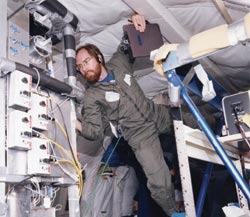![]() Current Issue
Current Issue
(Fall 2005)
Space Waste: Sharp Studies Why Astronauts Weaken
When a space shuttle lands safely, it would seem that the risks to its astronauts are over.
Yet many emergency scenarios could take place on the ground. A breach in the protective tiles could overheat the cabin. A fire or other dangerous event could occur.
"And it would take 45 minutes for the shuttle crew to be able to stand up and get out," says Keith Sharp, associate professor of mechanical engineering at Speed.
That’s because extended space flight causes astronauts to develop a condition called "postflight orthostatic intolerance."
It basically means, Sharp says, "that you've been out of gravity for so long that you can't tolerate standing up.
"It's probably the greatest cardiovascular problem NASA has," he adds.

Keith Sharp, associate professor of mechanical engineering, has flown several missions aboard NASA's "vomit comet" research plane to study how weightlessness affects the circulatory system. He's now creating a computer model at Speed that simulates the cardiovascular system in weightless conditions. (Photo courtesy of NASA.)
Sharp recently received a four-year NASA grant of nearly $500,000 to study this problem. Sharp's collaborator is Charles Knapp, a professor and director of the center for biomedical engineering at the University of Kentucky.
How the circulatory system works during space flight is a focus of Sharp’s research. To better understand this process, he is developing a computer model that will simulate how blood flows in the capillaries and how it is lost during weightlessness.
"We want to develop a computer model that simulates an astronaut’s cardiovascular system," Sharp says.
In zero-gravity conditions, the capillaries that carry the blood become more permeable, or leaky, and fluid can seep into other parts of the body.
"You lose blood in space—about a liter of blood volume, so you become volume depleted," Sharp says. That blood decrease causes less blood to get to organs and the brain.
"For astronauts who are standing for the first time after returning from space it means a lack of sufficient blood volume being pumped to the brain," he adds. "Brain cells are not getting enough oxygen. It’s not that the muscles lose strength, it's that the brain is not signaling the muscles to keep the astronaut standing.
"In effect, if you lose your brain, you lose your balance."
Sharp's model will allow him to study a range of circulating fluid volumes and capillary behavior in various conditions.
"We want to know why postflight orthostatic intolerance occurs. There is more than one hypothesis and we are investigating this one."
In the mid–1990s, Sharp conducted research aboard the so-called "vomit comet," NASA’s KC-135 zero-gravity research plane. During the up-and-down flights that create temporary weightlessness, Sharp studied a hydraulic cardiovascular system model.
"Our new project is a computer model version of that study," he says.
Sharp says he took about 20 flights on the nausea-inducing plane.
"I usually got sick—but it was for the good of science."